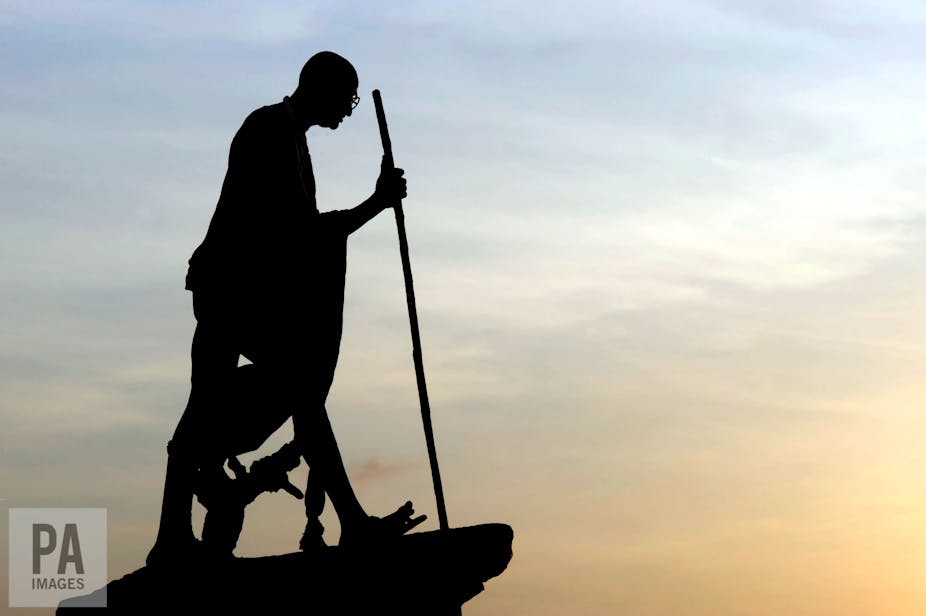The popular view of India’s journey to independence from British rule is the famous story of Mohandas Gandhi’s extraordinary campaign of non-violent protest. It is a heritage still marked today during international state visits.
But there was another, often forgotten – and much less peaceful – side to the struggle for Indian independence.
British colonial rule in India had been established through a series of wars fought across the subcontinent from the mid-18th century onwards. It was bloody and gradual, and rested on a thin foundation of coercion and military dominance.
This was made painfully clear by the uprising of 1857, in which a series of rebellions erupted across northern India, seriously undermining imperial confidence. Although the mutiny was crushed, the memory of it continued to inspire generations of Indian anti-colonialists, who would later refer to it as the First War of Independence.
While the events of 1857 were described by the colonial authorities in various terms including “mutiny”, “rebellion” and “insurgency”, the first act of anti-colonial violence to be given the label of “terrorism”, was carried out 40 years later.
In 1897, two brothers assassinated WC Rand, a civil service officer responsible for dealing with an outbreak of bubonic plague in the city of Pune, whose measures of forced home entry, bodily examinations and segregation were considered extremely heavy-handed.
Later, after colonial officials decided to partition the prosperous province of Bengal in 1905, non-violent forms of popular protest were accompanied by the growth of secret cells of revolutionaries who sought to undermine British imperial authority using targeted assassinations and bomb attacks.
Even though the partition was annulled in 1911, the revolutionary organisations it spawned did not disappear. In fact, they expanded massively.
On November 1 1913, Indian revolutionaries living in San Francisco published the first issue of Ghadar, or Mutiny, a radical weekly newspaper that quickly developed a global readership. By the summer of 1914, the Ghadar Party they founded was an international organisation, with more than 6,000 members and networks throughout North America, Europe, and Asia.

In February 1915, revolutionaries connected to the Ghadar party attempted to overthrow British rule through an ambitious uprising across northern India. Led by Rash Behari Bose, a veteran revolutionary who had personally attempted to assassinate the Viceroy of India in 1912, the revolutionaries tried to convince the Indian Army to mutiny by disseminating propaganda in Lahore, Rawalpindi, and Meerut.
The plot was foiled after a British-paid spy penetrated the organisation, prompting a huge crackdown in which hundreds of radicals were detained. Bose was forced to flee India, escaping to Japan where he would live out the rest of his life in exile.
The following month, Ghadar revolutionaries in the US acquired two ships, the Annie Larsen and the Maverick. They planned to land a huge arms shipment in Calcutta on Christmas Day. It was timed to coincide with another planned uprising in Burma, then still a part of British India, and a raid on the prison islands of the Andamans, in which incarcerated radicals would be liberated to take up arms against the British.
Like the February uprising, the Christmas Day plot was detected and foiled by the colonial intelligence services, which had expanded their operations to a global scale in response to the transnational reach of Ghadar.
With the implementation of strict wartime legislation such as the Defence of India Act, 1916 was a turning point for the revolutionary campaign, which was driven underground by imperial intelligence services, who detained several hundred suspected revolutionaries.
India’s revolutionary organisations did not vanish after World War I. As the war measures expired, the colonial government implemented the 1919 Rowlatt Act in an effort to extend executive powers into the postwar period. The proposed legislation permitted suspects to be interned without trial and allowed political cases to be tried without juries. This provoked outrage among the majority of the Indian population, who viewed it as an insult to their loyal service during the war.
At a gathering in Amritsar in April 1919, imperial troops opened fire on a crowd of unarmed protesters, killing at least 379 people and sparking nationwide anger.
Peace in his time
This is the context in which Mohandas Gandhi (usually called Mahatma out of respect) emerged to lead the Indian nationalist movement, which he rallied with a message of peaceful non-cooperation and non-violent resistance. Nonetheless, the more violent anti-colonial organisations formed in the years before and after World War I influenced both anti-colonial politics and imperial security right up until India’s independence and partition in 1947.

After the Second World War, many British officials were unsettled by fear of the Indian National Army, a military organisation made up of Indian prisoners of war released from Japanese custody and led by the famous nationalist Subhas Chandra Bose.
Despite being defeated militarily, the INA strengthened British unease that the continued occupation of India would be met by violent resistance. Following the end of the war, the trial of INA prisoners provided a serious problem for colonial legitimacy and helped to stoke the mass nationalism that forced Britain to withdraw in 1947.
So while it is the memory of Gandhi and non-violence that is now marked by British politicians when they visit India, the other side to the story is very real, and should not be forgotten.

Recalling the history of Indian revolutionaries isn’t just a matter of filling in historical gaps. It can help us gain some perspective on modern society by looking at the recent past.
And now a visit to India by the British Prime Minister Theresa May has included a pledge with the Indian PM Narendra Modi that India and the UK will work together to fight terrorism in both countries. It is not known whether or not they discussed the role that terrorism played in securing India’s independence from Britain. But perhaps they should have done – they would have had plenty to talk about.

